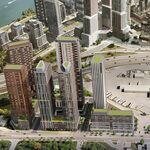Agreed on the parking - no need here
But even with it, I'm wondering if there's a specific design guideline that prevented adding a physical barrier here? or was this a political decision?
Retaining parking is a political decision.
Once that decision is made, you have certain requirements for how wide things have to be.
A parking lane is generally ~2.5M, a drive lane is typically 3.0-3.3M (usually the latter if its a curb lane and/or has truck or bus traffic.)
A bike lane itself would generally aim to be 1.8M-2.2M across, but can be as small as 1.5M
To add a buffer generally requires an additional 0.2M minimum (You can't eat into bike lane itself or the vehicle lane)
In the case of Gladstone, you have parking, 2 travel lanes for cars, and 2 bike lanes
Using the measurements I gave above, you can't even fit in what you see, meaning the bike lanes and vehicle lanes are both probably on the small side.
A plausible option would be to do a 3M, 2-way cycle track on one side, but that wasn't the option chosen. Its also tight.
For example, Wellington is approx the same width (from Niagara to Strachan) and it has nice separated facilities, so why wouldn't Gladstone have the same treatment, especially if the two (presumably) will eventually be connected to each other via Sudbury
I don't work for the City and can't provide that level of insight, except to note that Wellington is generally about 2M wider (15M vs 13M), Wellington's new design also delivers a 2-way cycle track, which takes up less space than 2 one-way tracks, and requires only one buffer.
****
Edit to add, you can see some UT discussion of this design when it was first contemplated, over here: (starting with
@smably 's post, then moving on to my thoughts at the time.)
?♂️ What a ridiculous oversight. I guess if you don't want to walk your bike down the stairs you have to cross the bridge, go down the ramp on the west side, and cross back at Pears. Yeah, bike gutter would have been easy to install

urbantoronto.ca
There's a link there to the project page, which is still up:
Project/Study Description Avenue Road Study The City of Toronto is studying Avenue Road, between Bloor Street West and St. Clair Avenue West, to find opportunities to improve the street, with emphasis on safety, mobility choices and enhancing streetscape. Bartlett-Havelock-Gladstone Cycling...

www.toronto.ca
I'll bring forward the cross-section so you can see how space is allocated:
So you can see the parking lane is sub optimal, the bike lanes are the bare minimum size and so are the car lanes. There's no wiggle room.
The solution here was eliminating the parking, sigh.
To compare, the Wellington design can be found here:
It shows cross-sections but w/o the measurements, but its still illustrative.

















